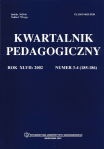The classical theory of drama and its educational implications
Klasyczna teoria dramatu i jej wychowawcze implikacje
Author(s): Krystyna Nowak-WolnaSubject(s): Education
Published by: Wydawnictwa Uniwersytetu Warszawskiego
Keywords: truth; good; beauty; art; creative activity; expression; drama; theatre; tragedy; comedy;; aesthetic education; aesthetic value
Summary/Abstract: Art is both an action and its result: creation (the work of art). Friedrich Nietzsche divided art into the Apollonian and Dionisyan one. The Apollonian element symbolizes the order and harmony, whereas the Dionisyan element leads to ecstasy and metamorphosis through pain. There guidance is needed from a teacher or a psychotherapist. The ecstasy and the purification of the soul can also be obtained through beauty (the Apollonian element) because under its influence the soul raises itself to the world of the ideas. Becoming beautiful in soul means becoming good at the same time. Participating in beautiful activities, staying among good people opens the “inner eye”. A man shapes himself maccording to the role model he admires. It is a route upwards described by Abraham Maslow in the 20 centuryth . A genre of art that influences people by means of both the Apollonian and the Dionisyan elements is drama. A drama can be looked upon from different points of view: as a way ofm human existence (man as a dramatic person), as one of three literary genres, and as a genre of stage art. From the point of view of the educative value of drama the most interesting theories are:the philosophical theory of Józef Tischner and the classical drama theory described extensively in Aristotle’s Poetics. The idea of kátharsis plays a specific role in the classical theory of drama catharsis. It means transformation, a sublimation of feelings. The medical dimension of the term is connected with the notion of homeostasis. In creative or receptive experience, a man’s manifested energy becomes intense to the highest degree, engaging the whole organism which leads to the establishment of well-being, the basis of both physical and psychological health. A drama is first of all an action, an open structure. A role is part of this structure. Identifying with the role leads to compassion and empathy, that carries a deep educative meaning. While learning our part we establish a contact with the stage person, while at the same time developing our ability to establish a contact with other people in our life. This function of drama could be called communicative. The drama remains connected with the play because of the plot and the actions of stage persons. The educative function of art is a moral-aesthetic function, it encompasses the whole man and shapes his/her everyday life. This function is a multi-level one. The first level consists in the influence through the very structure of the work, the second is an aesthetic-moral influence by means of derivative values of mimesis type. The third level is an aesthetic-practical influence acting through evoking a specific action. The division conforms with the well-known aesthetic tryad: the understanding, explanation, application. The first two levels refer to the theory of education, while the third one refers to the educative practice.
Journal: Kwartalnik Pedagogiczny
- Issue Year: 215/2009
- Issue No: 1
- Page Range: 59-94
- Page Count: 35
- Language: Polish
- Content File-PDF

